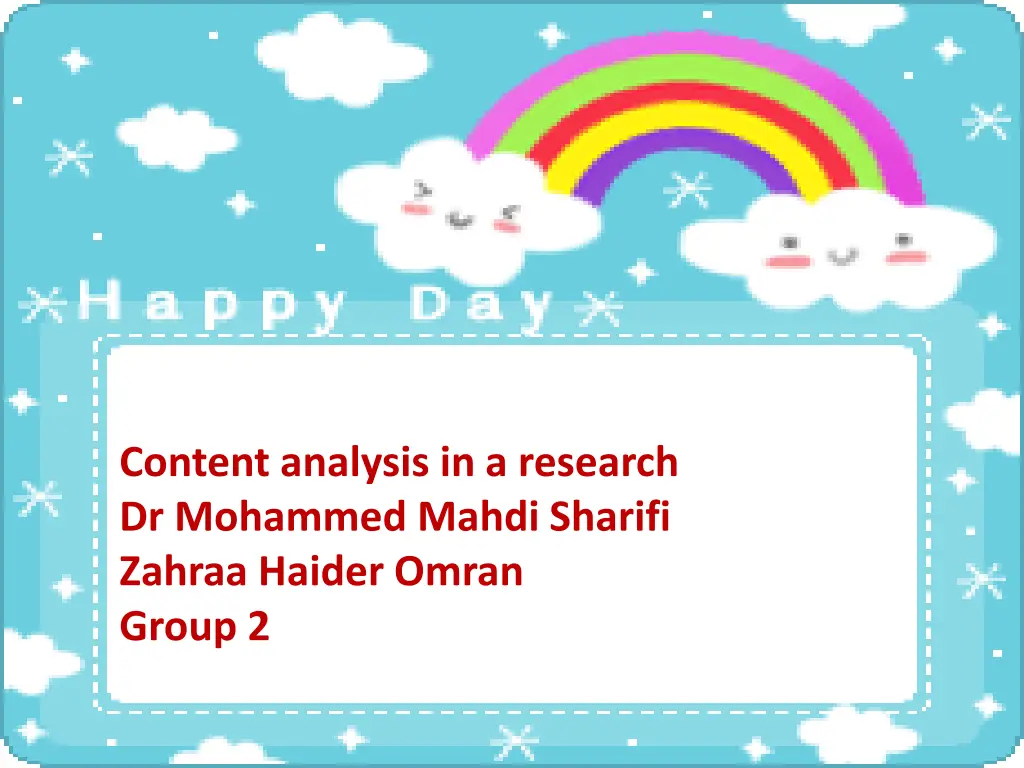
Understanding Content Analysis in Research Studies
Content analysis is a valuable research tool used to analyze qualitative data by identifying specific words, themes, and concepts. It helps in understanding communication trends, attitudes, and behaviors, revealing international and communication content patterns, and improving interventions. There are two main types of content analysis - conceptual analysis and relational analysis, each offering unique insights and interpretations for researchers to draw conclusions from.
Download Presentation

Please find below an Image/Link to download the presentation.
The content on the website is provided AS IS for your information and personal use only. It may not be sold, licensed, or shared on other websites without obtaining consent from the author. If you encounter any issues during the download, it is possible that the publisher has removed the file from their server.
You are allowed to download the files provided on this website for personal or commercial use, subject to the condition that they are used lawfully. All files are the property of their respective owners.
The content on the website is provided AS IS for your information and personal use only. It may not be sold, licensed, or shared on other websites without obtaining consent from the author.
E N D
Presentation Transcript
Content analysis in a research Dr Mohammed Mahdi Sharifi Zahraa Haider Omran Group 2
Content analysis is a research tool used to determine the presence of certain words, themes, or concepts within some given qualitative data (i.e. text). Using content analysis, researchers can quantify and analyze the presence, meanings and relationships of such certain words, themes, or concepts.
Any technique for making inferences by systematically and objectively identifying special characteristics of messages. (from Holsti, 1968) A research technique for the objective, systematic and quantitative description of the manifest content of communication. (from Berelson, 1952)
1. Identify the intentions, focus or communication trends of an individual, group or institution 2. Describe attitudinal and behavioral responses to communications 3. Determine psychological or emotional state of persons or groups 4. Reveal international differences in communication content 5. Reveal patterns in communication content 6. Pre-test and improve an intervention or survey prior to launch 7. Analyze focus group interviews and open-ended questions to complement quantitative data
Types of Content Analysis There are two general types of content analysis: conceptual analysis and relational analysis
Conceptual existence and frequency of concepts in a text. Relational analysis develops the conceptual analysis further by examining the relationships among concepts in a text. Each type of analysis may lead to different results, interpretations and meanings analysis determines the conclusions,
Conceptual Analysis Typically people think of conceptual analysis when they think of content analysis. In conceptual analysis, a concept is chosen for examination and the quantifying and counting its presence. The main goal is to examine the occurrence of selected terms in the data. Terms may be explicit or implicit. analysis involves
Relational Analysis Relational analysis begins like conceptual analysis, where a concept is chosen for examination. However, the analysis involves exploring the relationships between concepts. Individual concepts are viewed as having no inherent meaning and rather the meaning is a product of the relationships among concepts.
Advantages of Content Analysis Allows for both qualitative and quantitative analysis Provides valuable historical and cultural insights over time Allows a closeness to data Coded form of the text can be statistically analyzed Unobtrusive means of analyzing interactions Provides insight into complex models of human thought and language use When done well, is considered a relatively exact research method
Disadvantages of Content Analysis Is subject to increased error, particularly when relational analysis is used to attain a higher level of interpretation Is often devoid of theoretical base, or attempts too liberally to draw meaningful inferences about the relationships and impacts implied in a study Is inherently reductive, particularly when dealing with complex texts Tends too often to simply consist of word counts






















